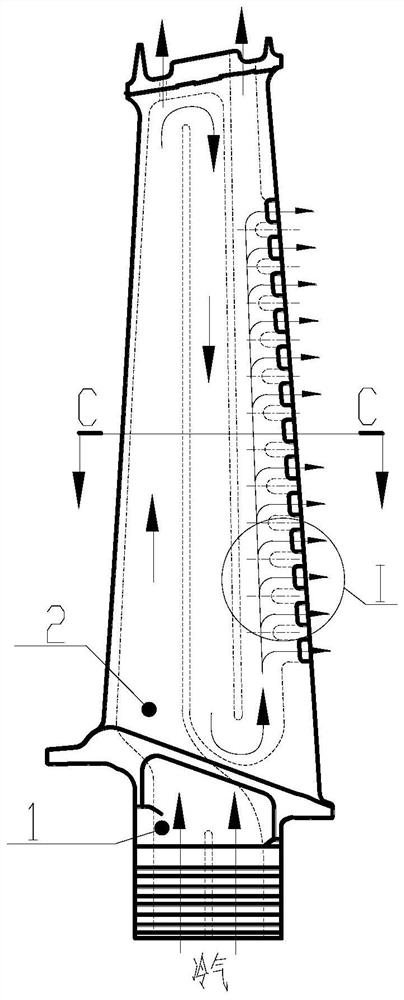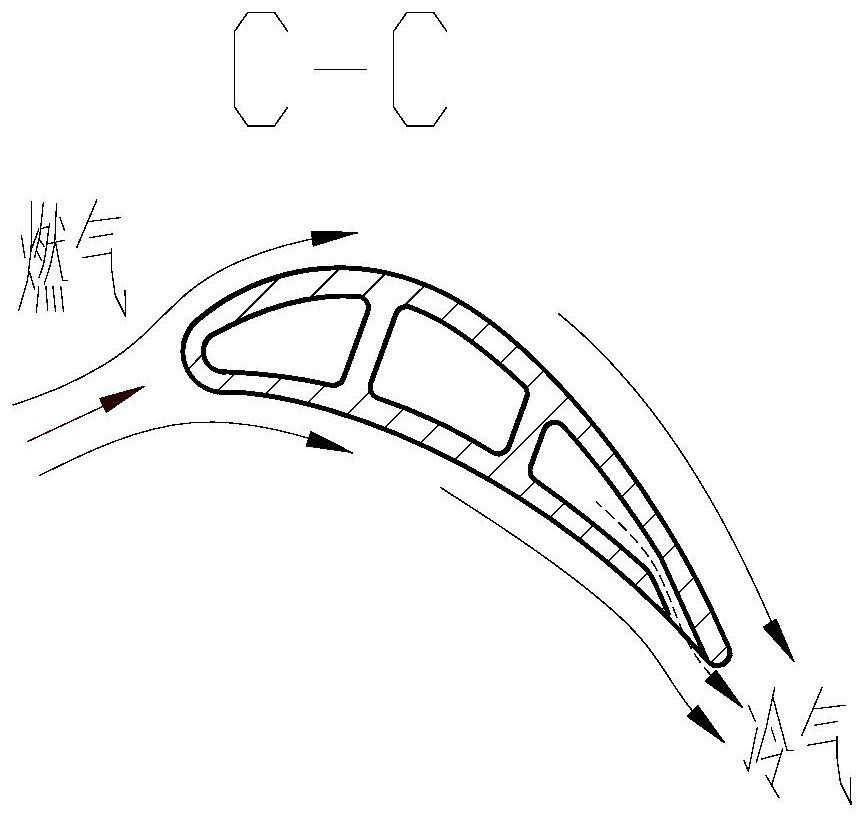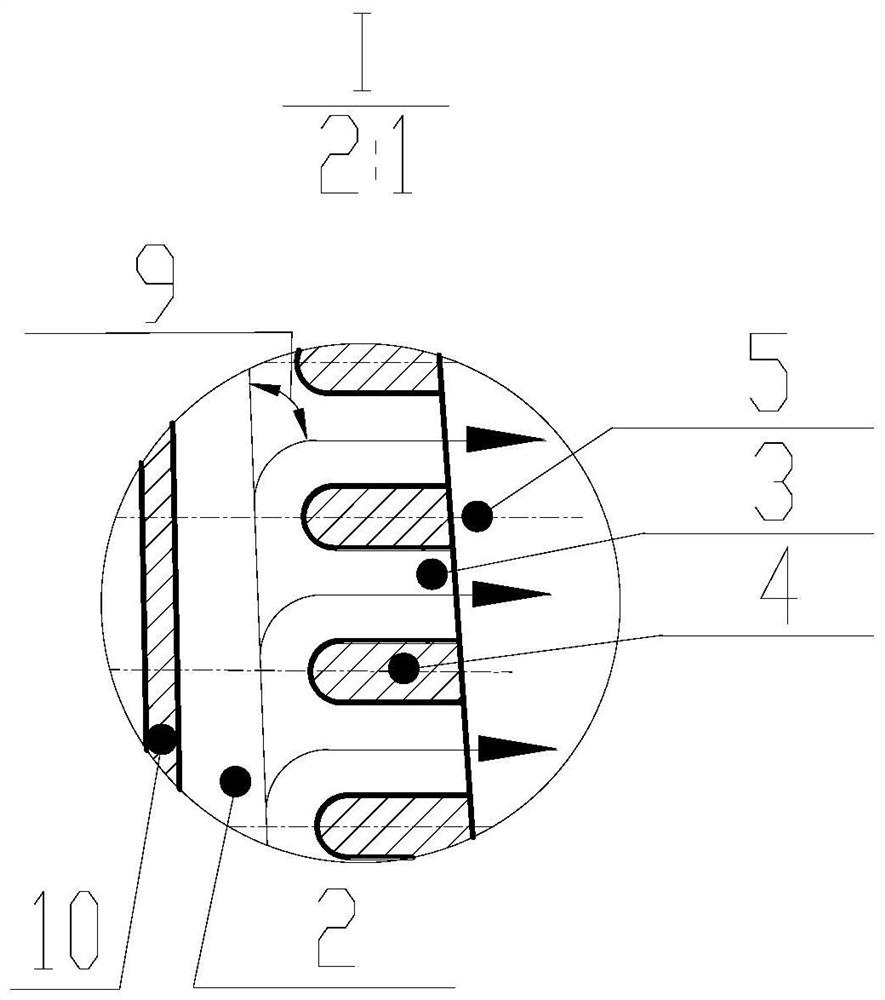A Curved Exhaust Slit Structure at the Trailing Edge of a Turbine Blade
A turbine blade, curved technology, applied in the direction of blade support elements, machines/engines, mechanical equipment, etc., can solve the problems of large flow resistance, damage to blade structure strength, low cooling effect, etc., to improve the load resistance ability and improve Casting manufacturability, effect of reducing flow resistance and loss
- Summary
- Abstract
- Description
- Claims
- Application Information
AI Technical Summary
Problems solved by technology
Method used
Image
Examples
Embodiment 1
[0036] See Figure 2. A turbine blade tail ridge curve exhaust cleaning structure, including hollow turbine blades 1, inner cavity air passage 2, tail edge exhaust cleaning passage 3 and tail edge cleft ribs 4;
[0037] The inner chamber air passage 2 is provided inside the hollow turbine blade 1, which is lowered in the inside of the blade and cools the blades. The hollow turbine blade 1 is provided with a side-by-side tail edge cleft rib 4, and the tail rolling passage 3 is arranged in a rib 4, and the tail edge exhaust cleaning passage 3 is formed, so as to discharge the blade of the cooling gas. The leaf tail margin is covered by the gas film. The structure of the tail edge cleft rib 4 can be guided by the inside of the blade in addition to the inside of the blade, and the inner chamber cooling gas is guided so that the direction of flow occurs.
[0038] The structural shape of the tail edge cleft rib 4 is controlled by the separation rib line 5, the separation rib line 5 is a ...
Embodiment 2
[0040] See Figure 2. A turbine blade tail ridge curve exhaust cleaning structure, including hollow turbine blades 1, inner cavity air passage 2, tail edge exhaust cleaning passage 3 and tail edge cleft ribs 4;
[0041] The structural shape of the tail edge cleft rib 4 is controlled by the separating rib line 5, the separating ribs center line 5 is a circular arc or a spline, corresponding to the tail edge cleft ribs 4 form an arc shape or a spline shape. The width of the tail edge cleft ribs 4 is symmetrically distributed along the centerline of the composite rib. Tail edge exhaust cleft center line 6 is an incident angle ∠ A1 and an exit angle ∠a2 in the tangential direction and the horizontal plane angle of the air turbine blade 1 and the horizontal plane angle. Typical values can be ∠A1 = 15 ° and ∠A2 = 0 °, at which time the cold air retreat is about 75 °.
Embodiment 3
[0043] See Figure 2. A turbine blade tail ridge curve exhaust cleaning structure, including hollow turbine blades 1, inner cavity air passage 2, tail edge exhaust cleaning passage 3 and tail edge cleft ribs 4;
[0044] The structural shape of the tail edge cleft rib 4 is controlled by the separating rib line 5, the separating ribs center line 5 is a circular arc or a spline, corresponding to the tail edge cleft ribs 4 form an arc shape or a spline shape. The width of the tail edge cleft ribs 4 is symmetrically distributed along the centerline of the composite rib. Tail edge exhaust cleft center line 6 is an incident angle ∠ A1 and an exit angle ∠a2 in the tangential direction and the horizontal plane angle of the air turbine blade 1 and the horizontal plane angle. Typical values can be ∠A1 = 25 ° and ∠A2 = 15 °, at which time the cold air turning angle is about 65 °.
PUM
 Login to View More
Login to View More Abstract
Description
Claims
Application Information
 Login to View More
Login to View More - R&D
- Intellectual Property
- Life Sciences
- Materials
- Tech Scout
- Unparalleled Data Quality
- Higher Quality Content
- 60% Fewer Hallucinations
Browse by: Latest US Patents, China's latest patents, Technical Efficacy Thesaurus, Application Domain, Technology Topic, Popular Technical Reports.
© 2025 PatSnap. All rights reserved.Legal|Privacy policy|Modern Slavery Act Transparency Statement|Sitemap|About US| Contact US: help@patsnap.com



